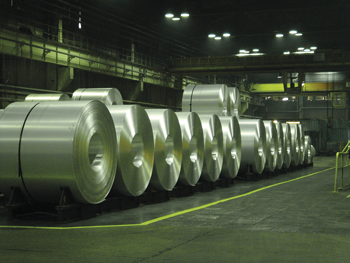US Tariffs and Sanctions Overwhelm the Metal Market
US tariffs and new sanctions against Russia will have unpredictable repercussions on the global aluminium industry
by Roberto Guccione
Tariffs and sanctions to draw the attention away from other issues
Trump’s tariff on aluminium is a negative measure for everyone, which will not have a great effect on the real issue, that is, the excess production capacity of the metal in China. China will not find it particularly difficult to place its production surplus elsewhere and sill have all the time to plan countermeasures, which will not be too difficult to devise, suffice it to say that China is the world’s largest holder of US treasury bonds. On the other hand the risk is that of waging an unprecedented trade war such as has not been seen in decades.
Centroal’s pragmatism
Centroal, Italy’s aluminium centre, is firmly against the United States’ decision of levying tariffs on aluminium imports. According to the President, Mauro Cibaldi, this measure will have a strong negative impact on the European and national industry, both directly, because of the limit placed on exports to the US, and indirectly, for the redirection of current commercial flows, which, instead of traveling towards the US, would end up reaching Europe.
Protests by the US downstream
Tariffs are a double-edged and very risky weapon: even in the US the new tariffs on aluminium introduced by Trump are raising a storm of protest, the highest level of alarm for over two million workers who operate in the machining and downstream uses of aluminium, such as containers for beverages, building and constructions, the automotive industry. The producers of primary aluminium, for the moment, are overjoyed, but they do not hide the uncertainty of the future. Alcoa, in a statement, underlined the “considerable uncertainty of the supply chain”, which complicates the market scenario. On a global level (including China, that is) the American group now expects a shortage of aluminium between 600,000 and one million tons in 2018, on the increase with respect to the 300-700 tons it foresaw three months ago.
After the tariffs, sanctions to Russia
Trade operators are baffled by the US sanctions against UC Rusal, a tidal wave which according to Jorge Vazquez, managing director of Harbor, one of the most closely followed analysts in the world regarding aluminium. US sanctions against Rusal could delete from the market more than 13% of the global production of aluminium (excluding the Chinese output), with unpredictable repercussions on the real market. The great dilemma is: is there a great strategic scheme behind all this or is it a petty electoral squabble? It is hard to provide a reply at the moment. Meanwhile, UC Rusal issued a statement where the heavy consequences of Trump’s sanctions are denounced: this is a small warfare picture which puts the activity of one of the largest primary producers and which predictably brings chaos to the market. The difficulty in securing supplies already sparked off an upswing in prices. Following sanctions, Rusal’s aluminium may ot even be delivered to LME warehouses and at the London Metal Exchange the price of aluminium marked a record high for the past seven years.
Let us not forget European tariffs
It has finally dawned on us that tariffs on raw materials which we need to import throw us put of the market, as is the case with primary aluminium. According to the European Trading Commissioner Cecilia Malmstroem the new US tariffs on aluminium and steel will have a negative impact on relationships across the Atlantic and on global markets. Besides, they will make costs increase and they will reduce options for industries using steel and aluminium. Since both the shortage of primary metal in Europe and the solid protectionist vision of EU primary producers are well-known, it is advisable to remind European supporters of tariffs on a material in short supply that the US market is now more attractive for those primary aluminium exporters, including European ones, exempted from the tariffs. The current price balance will inevitably lead to redirecting metal from Europe to North America, thereby increasing the European shortage of primary metal and of some raw aluminium products.

